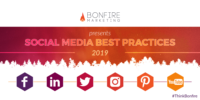Social media success can be determined by examining two areas: engagement and amplification. Engagement tells you how people are responding to and interacting with your content, and amplification tells you how people are promoting your content and advocating for your brand.
Here are a few key engagement and amplification metrics for four popular platforms, and where to find them!
Engagement
- Engagement rate gives you a good idea of how your posts are performing on a post-by-post basis. It’s also useful when analyzing the success of a specific time period, and month-over-month and year-over-year progress. To calculate your engagement rate, take the sum of a post’s reactions, comments, and shares and divide by the number of total post reach. Quickly access post-by-post information in your Facebook Business Manager by going to the Insights dropdown and choosing Posts.

- Engagement per post is similar to engagement rate and gives a good representation of overall post performance and the growth of engagement. For individual engagement-per-posts, refer to the same information in the image above. For month-over-month comparisons, take the sum engagement for all posts during the month and divide by the number of posts in the month.
- Website clicks, link clicks, and click-through-rate are a bit tricky to find on Facebook. In your Insights tab, you’ll be able to see total post clicks:

But that’s not what we care about. We want to know actual clicks to your website and clicks on links shared. Instead of digging around the Facebook native platform, it’s best to export your data by going to Insights > Overview > Export data > Select post data > Modify date range > Export data.

Once your data is exported, navigate to the “Lifetime Post consumers by type” tab and you’ll be able to see total link clicks in the “link clicks” column. Click-through-rate is key for measuring consistency of performance. If your clicks decreased, is it because people are clicking less or are posts reaching less people? Calculate your CTR by taking the number of link clicks your post received divided by the number of impressions.
Amplification
- Shares are the truest form of fan advocacy and more important than ever, considering Facebook’s latest News Feed update. Access this information by navigating Insights > Posts, and selecting Reactions, Comments, and Shares from the dropdown.

You can also find total share counts in Exported data > “Lifetime Post Stories by action” tab > “shares” column.
Engagement
- Mentions give you an idea of the true nature and depth of engagement opposed to vanity metrics such as likes. You can track your total monthly mentions on the home tab of Twitter Analytics:

- Link clicks are one of the main purposes of Twitter. They drive traffic to your website and content, so tracking link clicks is vital. To get a good idea of your content engagement and a more in-depth analysis, navigate to the tweets tab, select the appropriate date range, and export data. This will show you how many link clicks (“URL clicks” column) came from each tweet.
Amplification
- Retweets are similar to Facebook shares — pure fan advocacy. In your exported data, you’ll see tweet-by-tweet retweet counts in column H.
Engagement
- Engagement percentage tells you your engagement as a percentage of your total audience and is a good indicator of content success. Locate it by navigating the Analytics tab of your company LinkedIn page.

You’ll also be able to see clicks. Since LinkedIn has a limited native analytics platform, we recommend using a third-party reporting platform for deeper analysis.
Amplification
- Shares are the best indicator of content amplification across platforms. Due to the limits of LinkedIn analytics, use a third-party reporting platform for deeper insights.
Engagement
- Engagement rate shows how your posts are performing on a post-by-post basis and serves as a reference point for engagement growth. To calculate, take the sum total of likes and comments and divide by the number of total followers. This is particularly helpful in gaging success of content without the influence of a changing follower count.
- Engagement per post is the sum of likes and comments for individual posts. For month-over-month comparisons, take the sum of all comments and likes for all posts during the month and divide by the number of posts in the month.
Amplification
- Branded hashtag usage is a key indicator of fan advocacy and brand amplification, since Instagram doesn’t have a native share function. Track the number of images posted with branded hashtags.
Without diving into the analytics, you won’t have a clear understanding of your content engagement and success. But with it, you can guide your content strategy and measure the true success of your social media initiatives.
More Content
Fundamentals of Effective Marketing Reporting
Effective marketing isn’t based on hunches. That shouldn’t come as a shock to anyone, since we hear all the time about the importance of making data-informed decisions, regardless of what
5 Best Practices for a Hardware Product Launch
If you work in technology, you’re familiar with the hype around a new product launch. Hardware product launches these days are made for the digital world, and that means throwing
The Ultimate Social Media Best Practices 2019 [Infographic]
Jump ahead to best practices for: Facebook Posts Facebook Paid Posts LinkedIn Posts LinkedIn Sponsored Content Pinterest Pins Pinterest Promoted Pins YouTube Videos When I began my work with Bonfire,




Leave A Comment